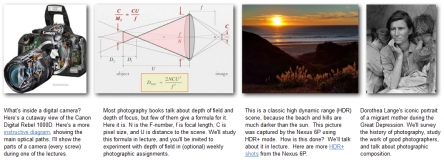
Marc Levoy
Professor Emeritus of Computer Science at Stanford
Principal Engineer at Google
Lecture Slides
History of Photography (part 1)
Photography Assignments
- Requirement 1: At least one photo must be poorly exposed. That is, most of the image should be either very close to black (underexposed) or close to flat white due to over-saturation (overexposed).
- Requirement 2: The main subject of at least one photograph should be motion-blurred, either due to movement of the subject or movement of the camera.
- Requirement 3: In at least one photo, nothing at all should be in focus. It’s hard to take a good looking photo where nothing is in focus – be creative!
- Requirement 4: You should use the wrong white balance setting for some intentional effect in at least one photo. The white balance setting on a camera tells the camera what color it should expect the scene illumination to be, for example daylight (which is bluish) or indoor incandescent (which is reddish). Most cameras have an “auto white balance (AWB)” setting, and manual settings for these other illumination types. You don’t need to understand white balance in detail to fulfill this requirement. It’s a subject we’ll cover in detail later in the course.
- Requirement 5: At least one photo should be poorly composed. If you’re not sure what to do you may want to consider an exactly centered subject that produces an oddly symmetric photo, a confusion between the subject and a background object, or a horizon that isn’t level. We will cover photographic composition in lecture in 2 weeks.
Challenge Questions
- Problem 1a. True or False? If camera apertures were square instead of circular, then F numbers will be separated by factors of 2 instead of sqrt(2).
- Problem 1b. True or False? In aperture priority mode, if you lower the F-number, the image gets brighter.
- Problem 1c. True or False? In-lens leaf shutters expose the center of the field of view longer than the corners.
- Problem 2. Which of the following statements are true about pinhole photographs? Assume the surface on which the image is formed is flat. Circle all that apply.
- (a) They are linear perspectives.
- (b) They have infinite depth of field.
- (c) Straight lines in the world can become curved in the photograph.
- (d) They are upside down, but if you rotate them 180 degrees they look correct.
- (e) They are upside down and if you rotate them they still read read backwards.
- (g) They are dim, unless the scene is very bright or you use a very long exposure.
- (h) They are in black and white.
- Problem 3. What is the minimum number of vanishing points there can be in a linear perspective drawing of a cube? Assume the cube is an open wire frame (or it’s made of glass, so you can see all 12 edges regardless of your viewpoint). Assume also that the cube measures 1 foot on a side, and you can’t stand more than a few feet away from it. Circle the best answer.
- (a) Zero
- (b) One
- (c) Two
- (d) Three
- (e) Infinitely many
There will be one vanishing point in a linear perspective image for every direction of light that is not parallel to the picture plane. No matter how you orient a cube, there will be at least one such direction, which goes “away from you”. This direction will have a vanishing point.
- Problem 4. You’re taking a picture of an athlete at f/2.8, 1/200s, and ISO 200. You realize that you want twice as much depth of field and half as much motion blur. What new settings do you use, if you want to keep the same amount of exposure?
-
- (a) f/4, 1/400s, ISO 200
- (b) f/4, 1/400s, ISO 400
- (c) f/4, 1/400s, ISO 800
- (d) f/5.6, 1/400s, ISO 800
- (e) f/5.6, 1/400s, ISO 1600
In order to double our depth of field we must use f/5.6, and in order to cut motion blur in half we must use 1/400s. The former decreases light by 4x and the latter decreases light by 2x, so we should increase our ISO by 8x to compensate, giving us answer (e).